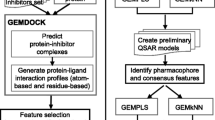Abstract
Successful development of novel drugs requires a close cooperation of experimental subjects, such as chemistry and biology, with theoretical disciplines in order to confidently design new chemical structures eliciting the desired therapeutic effects. Herein, especially quantitative structure-activity relationships (QSAR) as correlation models may elucidate which molecular features are significantly associated with enhancing a specific biological activity. In the present study, QSAR analyses of 30 pyridinium aldoxime reactivators for VX-inhibited rat acetylcholinesterase (AChE) were performed using the group method of data handling (GMDH) approach. The self-organizing polynomial networks based on GMDH were compared with multilayer perceptron networks (MPN) trained by 10 different algorithms. The QSAR models developed by GMHD and MPN were critically evaluated and proposed for further utilization in drug development.
Similar content being viewed by others
References
Dolezal, R., Korabecny, J., Malinak, D., Honegr, J., Musilek, K., Kuca, K.: Ligand-based 3D QSAR analysis of reactivation potency of mono- and bis-pyridinium aldoximes toward VX-inhibited rat acetylcholinesterase. J. Mol. Graph. Model. 56, 113–129 (2015)
Jokanovic, M., Prostran, M.: Pyridinium oximes as cholinesterase reactivators. Structure-activity relationship and efficacy in the treatment of poisoning with organophosphorus compounds. Curr. Med. Chem. 16, 2177–2188 (2009)
Gorecki, L., Korabecny, J., Musilek, K., Malinak, D., Nepovimova, E., Dolezal, R., Jun, D., Soukup, O., Kuca, K.: SAR study to find optimal cholinesterase reactivator against organophosphorous nerve agents and pesticides. Arch. Toxicol. 90, 2831–2859 (2016)
Waisser, K., Dolezal, R., Palat, K., Cizmarik, J., Kaustova, J.: QSAR study of antimycobacterial activity of quaternary ammonium salts of piperidinylethyl esters of alkoxysubstituted phenylcarbamic acids. Folia Microbiol. 51, 21–24 (2006)
Patel, H.M., Noolvi, M.N., Sharma, P., Jaiswal, V., Bansal, S., Lohan, S., Kumar, S.S., Abbot, V., Dhiman, S., Bhardwaj, V.: Quantitative structure–activity relationship (QSAR) studies as strategic approach in drug discovery. Med. Chem. Res. 23, 4991–5007 (2014)
Ivakhnenko, A.G.: Heuristic self-organization in problems of engineering cybernetics. Automatica 6, 207–219 (1970)
Ebtehaj, I., Bonakdari, H., Zaji, A.H., Azimi, H., Khoshbin, F.: GMDH-type neural network approach for modeling the discharge coefficient of rectangular sharp-crested side weirs. Eng. Sci. Technol. Int. J. 18, 746–757 (2015)
Nikolaev, N.Y., Iba, H.: Polynomial harmonic GMDH learning networks for time series modeling. Neural. Netw. 16, 1527–1540 (2003)
Abdel-Aal, R.E.: GMDH-based feature ranking and selection for improved classification of medical data. J. Biomed. Inform. 38, 456–468 (2005)
Dolezal, R., Trejbal, J., Mesicek, J., Milanov, A., Racakova, V., Krenek, J.: Designing QSAR models for promising TLR4 agonists isolated from Euodia asteridula by artificial neural networks enhanced by optimal brain surgeon. In: Nguyen, N.-T., Manolopoulos, Y., Iliadis, L., Trawiński, B. (eds.) ICCCI 2016. LNCS, vol. 9876, pp. 271–281. Springer, Cham (2016). doi:10.1007/978-3-319-45246-3_26
Acknowledgements
This work was supported by the project “Smart Solutions for Ubiquitous Computing Environments” FIM UHK, Czech Republic (under ID: UHK-FIM-SP-2017-2102). This work was also supported by long-term development plan of UHHK, by the IT4Innovations Centre of Excellence project (CZ.1.05/1.1.00/02.0070), and Czech Ministry of Education, Youth and Sports project (LM2011033).
Author information
Authors and Affiliations
Corresponding author
Editor information
Editors and Affiliations
Rights and permissions
Copyright information
© 2017 Springer International Publishing AG
About this paper
Cite this paper
Dolezal, R. et al. (2017). ANN and GMDH Algorithms in QSAR Analyses of Reactivation Potency for Acetylcholinesterase Inhibited by VX Warfare Agent. In: Nguyen, N., Papadopoulos, G., Jędrzejowicz, P., Trawiński, B., Vossen, G. (eds) Computational Collective Intelligence. ICCCI 2017. Lecture Notes in Computer Science(), vol 10449. Springer, Cham. https://doi.org/10.1007/978-3-319-67077-5_17
Download citation
DOI: https://doi.org/10.1007/978-3-319-67077-5_17
Published:
Publisher Name: Springer, Cham
Print ISBN: 978-3-319-67076-8
Online ISBN: 978-3-319-67077-5
eBook Packages: Computer ScienceComputer Science (R0)




